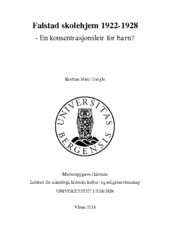Falstad skolehjem 1922-1928: - En konsentrasjonsleir for barn?
Master thesis
Permanent lenke
https://hdl.handle.net/1956/18179Utgivelsesdato
2018-06-16Metadata
Vis full innførselSammendrag
This master thesis explores the confinement, monitoring and discipline of boys whom the authorities labelled delinquent and sent to Falstad reformatory school during the years between 1922 and 1928. The reformatory school was located near a farm adjacent to a nearby village and had an isolated location in the countryside. The boys therefore had little contact with others. During the period this thesis explores, the reformatory school was housed in a building inspired by prison architecture and designed to control and monitor the boys. For instance, the boys were locked into small dark cells at night. The reformatory school building was later used as a prison camp during World War II, without being rebuilt. This tells a lot about the architecture of the building. The boys had long working days on the fields and in the workshops. In the evenings they learnt basic skills such as writing, reading and numeracy. They were monitored 24 hours a day and were not allowed to move outside the premises. There were strict rules at the reformatory school and violations of these were punished severely, including isolation and physical punishment. In this thesis I will focus on cases of neglect and abuse, and investigate why several actors called Falstad reformatory school a concentration camp for children.
